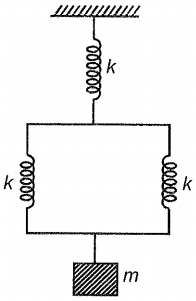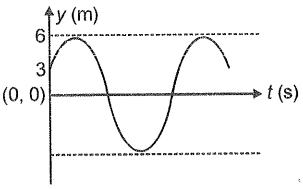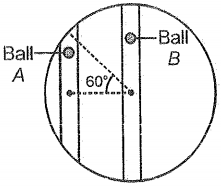A body of mass m hanging with the help of three springs, each of spring constant k as shown. If the mass is slightly displaced and released, then the system will oscillate with the time period

1.
2.
3.
4.

A block of mass m attached to a spring of constant k oscillates on a smooth surface. The other end of the spring is fixed to a wall. When spring is at its natural length, the speed of the block is v. Displacement of the block from its mean position before coming to instantaneous rest is:
1.
2.
3.
4.
A particle under SHM has a maximum speed of 30 cm/s and a maximum acceleration of 60 cm/s? The time period of oscillation (in second) is
1.
2. 2
3.
4. 4
The x-t graph of a particle undergoing SHM is shown below. The acceleration of the particle at is:

1.
2.
3.
4.
The position-time (y - t) graph of a particle executing S.H.M. is shown. The time period of the particle is 4 seconds. Equation of particle executing S.H.M. is

1.
2.
3.
4.
A particle starts executing SHM from an extreme position with time period T and amplitude A. The distance travelled by the particle in time is:
1. 3.5 A
2. 2.5 A
3. 0.5 A
4. 1.5
Two tunnels are dug across the earth as shown in the figure. Balls A and B are dropped in the tunnels. If the time period of oscillation of ball A is T, the time period of the oscillation of ball B is :

1. T
2.
3.
4.
Select the correct statement(s) regarding S.H.M.
1. The average speed of particle executing S.H.M. is zero in one complete oscillation.
2. The graph between the kinetic and potential energy of a particle executing S.H.M. is a straight line.
3. Restoring force acting on the particle is directed towards a fixed point and is directly proportional to the displacement from the mean position of the particle.
4. Both (2) & (3)
The graph between the velocity \((v)\) of a particle executing SHM and its displacement \((x)\) is shown in the figure. The time period of oscillation for this SHM will be:
1. \(\sqrt{\frac{\alpha}{\beta}}\)
2. \(2\pi\sqrt{\frac{\alpha}{\beta}}\)
3. \(2\pi\left(\frac{\beta}{\alpha}\right)\)
4. \(2\pi\left(\frac{\alpha}{\beta}\right)\)
The displacement of a body performing simple harmonic motion is represented by . After what approximate time from t = 0, the speed of the particle becomes maximum for the first time?
1. 0.12 s
2. 0.24 s
3. 0.33 s
4. 0.42 s







